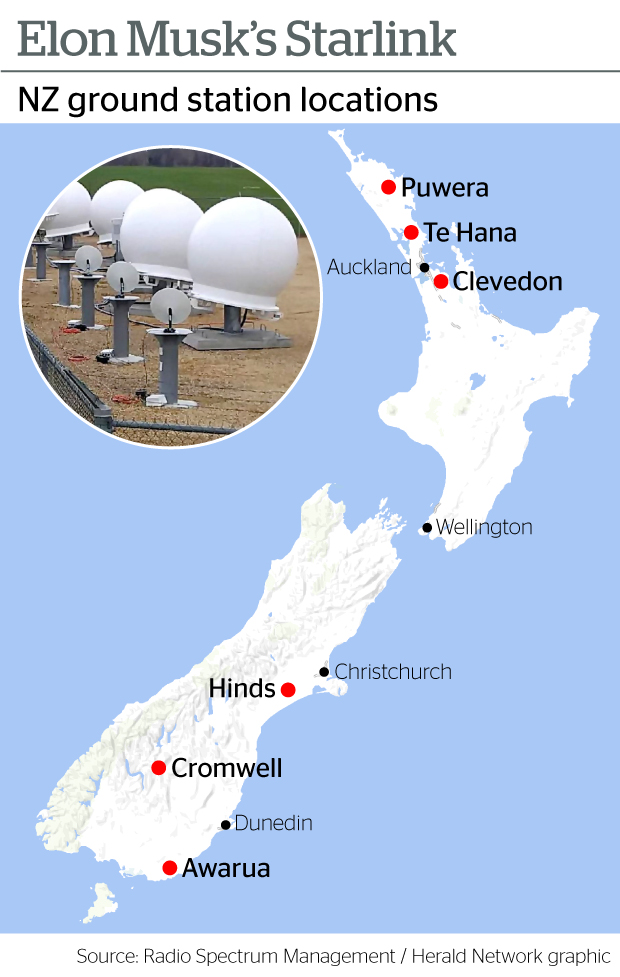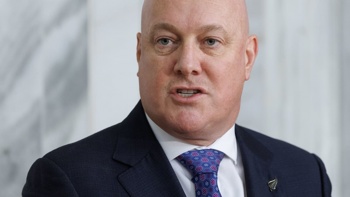A West Auckland resident was shocked last night when she saw a train of fast-moving light shoot across the sky before reaching for her camera.
Sky Stansfield, a resident in the small Auckland community of Laingholm - situated in the Waitākere Ranges - says she was home when her four-year-old son came running in to tell her about a “rocketship” outside.
“It was actually my four-year-old son that saw it first and he came inside and told me because he thought it was a rocketship,” Stansfield told the Herald.
Stansfield said the satellites were in a line and moving very quickly from west to east before disappearing into the night sky.
/cloudfront-ap-southeast-2.images.arcpublishing.com/nzme/GPHMSIDH3ZACRN2KERKPJWTN7Y.jpg)
A lucky photographer captured a train of SpaceX's Starlink satellites on camera last night above Auckland. Photo / Sky Stansfield
“I had absolutely no idea what they were,” she said.
After further research, Stansfield discovered that the train of “around 20 to 30″ lights were part of Elon Musk’s SpaceX Starlink satellite mission.
The lights were also seen above Warkworth earlier in the year.
According to findstarlink.com, Aucklanders will next be able to spot them shooting through the sky from southwest to south at 7.24pm on April 9 for five minutes.
What are the SpaceX Starlink satellites?
Starlink is part of Elon Musk’s grand vision of offering fibre-speed internet from above.
They are more than 1700 satellites operated by Elon Musk’s SpaceX which deliver internet access to remote spots as they communicate with ground-based transceivers from low Earth orbit.
The reason they first appear as a chain is because that’s really what they are: stacks of dozens of flat-panel satellites, weighing just over a quarter of a tonne each.
/cloudfront-ap-southeast-2.images.arcpublishing.com/nzme/NU3LE2HC6VFIZHWFBDTB2KIOTE.jpg)
Elon Musk hopes to boost his current swarm of 1000 satellites to 12,000, which will provide fast internet to the entire planet. Photo / SpaceX
With the help of krypton-fuelled ion thrusters, the satellites disperse and climb into their operating orbit, at an altitude of around 550km.
Most satellite internet services today come from single geostationary satellites that orbit the planet much higher, at about 35,000km.
Starlink began offering its public beta service to New Zealand customers last year, with monthly packages of unlimited data selling at $159.
Over the past few days, Starlink has been promoting a deal - via the Elon Musk-owned Twitter - for New Zealanders to get Starlink’s install kit (satellite dish for receiving broadband, cable and a special wi-fi router) for just $199. The usual price is $1049.

Starlink currently provides access to 48 countries.
Amid widespread fibre and mobile network outages across the North Island during Cyclone Gabrielle, users of Starlink reported that their connections remained stable – as long as their power and hardware held up.
There are six Starlink ground stations set up in New Zealand - three in the North Island (Puwera, Te Hana and Clevedon) and three in the South (Hinds, Cromwell and Awarua).
What are the problems?
Along with the purely aesthetic issue of more clutter in our skies, astronomers have raised some obvious issues.
They’ve suggested that the number of visible satellites might come to outnumber visible stars – and that their brightness, on optical and radio wavelengths, could disrupt scientific observations.
Some scientists have warned this light pollution – which SpaceX has moved to address - could even affect astronomers searching space for Earth-threatening asteroids.
There have also been concerns the constellations could mess with future space travel, or worsen the already significant risk posed by space debris.
“We don’t know whether we’re actually reaching a tipping point,” said Nelson-based space scientist Dr Duncan Steel.
/cloudfront-ap-southeast-2.images.arcpublishing.com/nzme/URCX3AT5BBDGPNMM2GUDQTE7HI.jpg)
Launch of Starlink Mission on a SpaceX rocket in January 2020. Photo / SpaceX 29
“A lot of the Starlink satellites are in relatively low orbits and aren’t expected to remain up there forever - they will re-enter [the atmosphere] and that’s a preferable thing to staying up there forever.”
The problem was, he said, whether the satellites disintegrated into debris.
Some critics have warned of the risk of satellite collisions, potentially triggering a cascade of more collisions called the Kessler syndrome – and even keeping humans stuck on Earth.
SpaceX has said most of its satellites are launched at lower altitude, with failed satellites expected to deorbit within five years without propulsion.
One NZ and Starlink merger
The company formerly known as Vodafone NZ formally started trading as One NZ on Monday - and marked the occasion by revealing a partnership with the Musk-owned Starlink.
The deal follows one already signed between Musk’s company and T-Mobile in the US. That deal will see T-Mobile users able to send texts via Starlink by the end of the year when out of usual cellular coverage areas.
One NZ CEO Jason Paris said customers will be able to send texts via Starlink’s Direct to Cell by “late 2024″ with voice and data to follow.
“The cool thing about working with SpaceX on satellite-to-mobile technology is that works with your normal smartphone, so you don’t need one of those big bricks,” Paris said.
/cloudfront-ap-southeast-2.images.arcpublishing.com/nzme/LE3L34KLXNB3VLOMWWR3W7PQSQ.jpg)
Jason Paris and One NZ marked a major occasion by revealing a partnership with the Elon Musk-owned Starlink. Photo / Michael Craig
Both T-Mobile and One NZ are waiting on Starlink to launch around 2000 “second generation” satellites to enable the mobile network tie-up. SpaceX has said the second-generation birds require its new, larger Starship rocket to launch. Starship could have its maiden flight as early as this month.
Paris said he had written to the Government, pledging that One’s 100 per cent coverage Starlink Direct Cell service would be made available to Spark and 2degrees customers for emergency calls, and to all emergency services.
The initial text implementation would be for One customers only, however.
Take your Radio, Podcasts and Music with you









